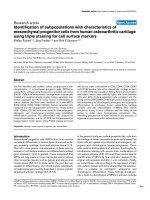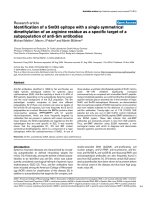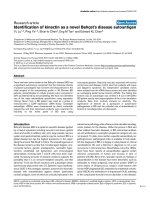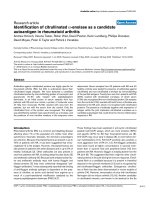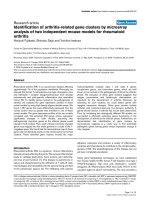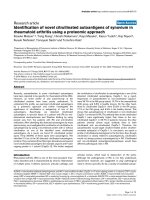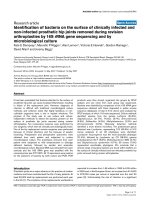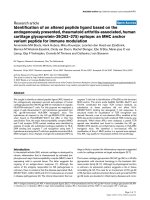Báo cáo y học: "Identification of HLA-DRPheβ47 as the susceptibility marker of hypersensitivity to beryllium in individuals lacking the berylliosis-associated supratypic marker HLA-DPGluβ69" pot
Bạn đang xem bản rút gọn của tài liệu. Xem và tải ngay bản đầy đủ của tài liệu tại đây (830.99 KB, 9 trang )
BioMed Central
Page 1 of 9
(page number not for citation purposes)
Respiratory Research
Open Access
Research
Identification of HLA-DRPheβ47 as the susceptibility marker of
hypersensitivity to beryllium in individuals lacking the
berylliosis-associated supratypic marker HLA-DPGluβ69
Massimo Amicosante*
1
, Floriana Berretta
1
, Milton Rossman
2
,
Richard H Butler
3
, Paola Rogliani
1
, Ella van den Berg-Loonen
4
and
Cesare Saltini
1
Address:
1
Department of Internal Medicine, University of Rome "Tor Vergata", Rome, Italy,
2
Pulmonary, Allergy and Critical Care Division,
Department of Medicine, Hospital of the University of Pennsylvania, Philadelphia, Pennsylvania, USA,
3
Institute of Cell Biology, National
Research Council, Monterotondo (Rome), Italy and
4
Tissue Typing Laboratory, University Hospital Maastricht, Maastricht, The Netherlands
Email: Massimo Amicosante* - ; Floriana Berretta - ;
Milton Rossman - ; Richard H Butler - ; Paola Rogliani - ; Ella van den
Berg-Loonen - ; Cesare Saltini -
* Corresponding author
Abstract
Background: Susceptibility to beryllium (Be)-hypersensitivity (BH) has been associated with HLA-DP alleles carrying a
glutamate at position 69 of the HLA-DP β-chain (HLA-DPGlu69) and with several HLA-DP, -DQ and -DR alleles and
polymorphisms. However, no genetic associations have been found between BH affected subjects not carrying the HLA-
DPGlu69 susceptibility marker.
Methods: In this report, we re-evaluated an already described patient populations after 7 years of follow-up including
new 29 identified BH subjects. An overall population 36 berylliosis patients and 38 Be-sensitization without lung
granulomas and 86 Be-exposed controls was analysed to assess the role of the individual HLA-class II polymorphisms
associated with BH-susceptibility in HLA-DPGlu69 negative subjects by univariate and multivariate analysis.
Results: As previously observed in this population the HLA-DPGlu69 markers was present in higher frequency in
berylliosis patients (31 out of 36, 86%) than in Be-sensitized (21 out of 38, 55%, p = 0.008 vs berylliosis) and 41 out of
86 (48%, p < 0.0001 vs berylliosis, p = 0.55 vs Be-sensitized) Be-exposed controls.
However, 22 subjects presenting BH did not carry the HLA-DPGlu69 marker. We thus evaluated the contribution of all
the HLA-DR, -DP and -DQ polymorphisms in determining BH susceptibility in this subgroup of HLA-Glu69 subjects. In
HLA-DPGlu69-negatives a significant association with BH was found for the HLA-DQLeu26, for the HLA-DRB1 locus
residues Ser13, Tyr26, His32, Asn37, Phe47 and Arg74 and for the HLA-DRB3 locus clusterized residues Arg11, Tyr26,
Asp28, Leu38, Ser60 and Arg74. HLA-DRPhe47 (OR 2.956, p < 0.05) resulting independently associated with BH.
Further, Be-stimulated T-cell proliferation in the HLA-DPGlu69-negative subjects (all carrying HLA-DRPhe47) was
inhibited by the anti-HLA-DR antibody (range 70–92% inhibition) significantly more than by the anti-HLA-DP antibody
(range: 6–29%; p < 0.02 compared to anti-HLA-DR) while it was not affected by the anti-HLA-DQ antibody.
Conclusion: We conclude that HLA-DPGlu69 is the primary marker of Be-hypersensitivity and HLA-DRPhe47 is
associated with BH in Glu69-negative subjects, likely playing a role in Be-presentation and sensitization.
Published: 14 August 2005
Respiratory Research 2005, 6:94 doi:10.1186/1465-9921-6-94
Received: 31 March 2005
Accepted: 14 August 2005
This article is available from: />© 2005 Amicosante et al; licensee BioMed Central Ltd.
This is an Open Access article distributed under the terms of the Creative Commons Attribution License ( />),
which permits unrestricted use, distribution, and reproduction in any medium, provided the original work is properly cited.
Respiratory Research 2005, 6:94 />Page 2 of 9
(page number not for citation purposes)
Background
Due to its unique chemical-physical properties, beryllium
(Be) compounds continue to be used in aerospace, ceram-
ics, defence, electronics and telecommunication indus-
tries where inhalation of Be dust is the cause of Be-
hypersensitivity (BH) in susceptible individuals [1].
Among subjects developing Be-hypersensitivity, all show
sensitization, i.e. T-cell reactivity to Be revealed by either a
blood or a bronchalveolar lavage cell test. Less than 50%
of subjects with BH present which chronic disease [1-3]
i.e., with chronic granuloma formation in the lung main-
tained by the accumulation in the lower respiratory tract
of CD4+ T-cells responding to Be as a specific antigen/
hapten [4], presenting an effector-memory phenotype
[5,6] and producing Th1 cytokines upon Be stimulation
[4-6].
The observation that beryllium disease affects only 1 to
16% of Be-exposed individuals led to the hypothesis that
genetic susceptibility may play an important role in the
pathogenesis of this disease [1]. In 1993, the HLA-DP
supratypic variant characterized by a glutamic acid at posi-
tion 69 of the HLA-DP molecule β chain (DPGlu69) was
identified as a genetic marker of susceptibility to BH, an
observation subsequently confirmed by seven independ-
ent studies [7-14]. Two independent studies have also
identified the HLA-DPGlu69 marker as the immune
response gene responsible for presentation of Be to Be-
specific T-cells [15,16] and an immunochemical study has
suggested that the structural basis for Be presentation by
the HLA-DPGlu69 positive molecule is in its unique abil-
ity to bind beryllium with high affinity possibly in the
context of a coordination bond formed by the contribu-
tion of other electron donor groups present in the fourth
pocket of the peptide binding groove of the HLA-DP mol-
ecule [17]. Further, antibody inhibition studies have
shown that Be-presentation to blood and lung T-cells in
DPGlu69-positive subjects is inhibited almost exclusively
by anti-HLA-DP antibodies [16,18], strongly indicating
HLA-DPGlu69 as the immune response gene used by
DPGlu69-positive subjects i.e., about 80% of the BH
affected population [7-14].
In contrast, the HLA gene which might function as the
immune response gene in DPGlu69-negative BH-affected
subjects i.e., in the remaining 20% of the BH affected pop-
ulation, has not yet been determined.
Previous studies have identified the HLA-DRB1 alleles
belonging to the *01 group [13] as negatively associated
with berylliosis, while the HLA-DRB1 variants Ser11 [12],
Tyr26 [10], Asn37 [12], Glu71 [12] and Arg74 [10] and
the HLA-DQ variant Gly86 [12] were positively associated
with BH. Analysis of the role of these markers has, how-
ever, been hampered by the small size of the populations
examined in most studies. In all studies published so far,
the putative susceptibility markers covered only 40 to
50% of the DPGlu69-negative subjects. In this context,
our previous study [10] on 45 individuals affected by
beryllium sensitization with or without demonstrable
lung granulomas, showed that HLA-DR Arg74 and Tyr26
were associated with sensitization without lung granulo-
mas, and HLA-DP Glu69 with sensitization accompanied
by lung granulomas, thereby suggesting a different role for
Glu69 and these markers [10]. However, in the HLA-
DPGlu69 negative subjects reported in the Saltini et al.
study population, HLA-DR Arg74 and Tyr26 were
expressed only by 11 out of 19 DPGlu69 negative sensi-
tized subjects 10 of which without and one with demon-
strable lung granulomas [10]. In another study in the field
conducted by Rossman et al. [12] evaluating 56 BH
affected subjects, four out of seven DPGlu69 negative
patients carried either DRAsn37, DRGlu71 or DQGly86
[12]. Finally, Maier and co-workers [13], in 19 HLA-DP
Glu69-negative BH subjects, found that HLA-DRB1*13
alleles were associated with BH susceptibility; however,
they were only expressed by 12 of these subjects.
In order to search for this(these) disease associated
immune response gene(s), we re-evaluated a previously
described population [10] after a follow up of 7 years that
allowed us to extend the study to other 29 newly identi-
fied BH subjects (14 with biopsy proven lung granulomas
and 15 with Be-sensitization without lung granulomas)
for a total number of 74 BH subjects and 86 Be-exposed
controls. This panel included a sufficiently large number
of DPGlu69-negative subjects to analyze phenotypic fre-
quencies of all aminoacid variants of the HLA-DPB1, -
DQB1, -DRB1, -DRB3, -DRB4 and DRB5 genes in BH
affected and Be exposed controls.
Methods
Study population
The study population, already described in part in a previ-
ous study [10], includes 86 Be exposed healthy controls
and 74 subjects affected by beryllium hypersensitivity, all
working in the same beryllium manufacturing plant, 45 of
whom (23 Be-sensitized subjects and 22 berylliosis
affected i.e., Be-sensitized subjects with biopsy proven
lung granulomas) have been already described in the
Saltini et al. report [10]. Study subjects are categorized as
(i) Be-exposed controls, when having negative blood Be-
LPT test, (ii) Be-sensitized, when having 2 blood BeLPT
positive tests and (iii) berylliosis-affected when having 2
blood BeLPT positive tests and/or biopsy proven lung
granulomas [10]. While 4 control subjects were diagnosed
with beryllium sensitization and 3 with berylliosis during
the 7-years follow up, none of the subjects in the previous
study progressed from sensitization to berylliosis.
Respiratory Research 2005, 6:94 />Page 3 of 9
(page number not for citation purposes)
Overall the population in this report included 36 beryllio-
sis (age 40 ± 7 years; 33 Caucasians, 2 African-Americans
and 1 Asian; 32 males and 4 females; mean duration of
Be-exposure 11 ± 7 years) and 38 showed Be-sensitization
without lung granulomas detected by trans-bronchial
biopsy (age 43 ± 9 years; 37 Caucasians and 1 Afro-Amer-
ican; 31 males and 7 females; mean age of Be-exposure 17
± 9 years) and 86 Be-exposed controls (age 44 ± 9 years;
81 Caucasians, 2 African-American, 2 Hispanics, 1 Asian;
71 males and 15 females; mean duration of Be-exposure
16 ± 11 years).
High resolution HLA class II typing
High resolution HLA-class II typing for the HLA-DPB1,
DQB1, DRB1, DRB3, DRB4, DRB5 loci were performed by
standard protocols as already reported [10].
Beryllium lymphocyte proliferation test (Be-LPT)
The Be-LPT as measures of the T-cell lymphocytes
response against Be in peripheral blood has been per-
formed by standard method [19]. Briefly, peripheral
blood mononuclear cells (PBMC) were tested against
three doses beryllium sulfate (BeSO
4
*4H
2
O) at 1, 10, and
100 µM at 3 and 5 days. T-cell proliferation were evalu-
ated by tritium (
3
H) labelled thymidine incorporation
and a stimulation index (SI) calculated as the ratio of the
radioactivity (counts per minute) of beryllium-exposed
cell cultures to the count rate of unstimulated cultures. A
test was defined as abnormal when two or more stimula-
tion index values of six possible values exceeded the nor-
mal standard ratio of 3.0 (stimulated to unstimulated) as
the cut-off.
Lymphocyte proliferation to Be salt and monoclonal
antibody (MoAb) inhibition of lymphocyte activation
T-cell proliferation in response to BeSO
4
and inhibition
by anti-HLA class II MoAbs were performed as previously
described [18]. Briefly, PBMCs obtained from patients
with BH were isolated from heparinized whole blood by
density centrifugation on Ficoll Hypaque gradient.
PBMCs (2 × 10
5
cells/well) were then cultured in 96-well
flat-bottomed microtiter plates in RPMI 1640 tissue cul-
ture medium supplemented with 2 mM L-glutamine, 10%
fetal bovine serum, 100 U/ml penicillin, and 100 µg/ml
streptomycin in the presence of beryllium sulfate
(BeSO
4
*4H
2
O) at 10–50–100 µM (all reagents form
Sigma Co., St. Louise, MO). Phytohemoagglutinin (PHA,
5 µg/ml, Sigma) and Candida albicans (10 µg/ml) were
used as positive controls. T lymphocyte proliferation was
measured by [3H]TdR incorporation. Cells were pulsed
with 1 µCi of [
3
H]TdR (Amersham International, Amer-
sham, UK) after 5 days of culture and harvested onto glass
fiber filters 18 hours later. Proliferation was measured as
3
H-TdR incorporation by liquid scintillation spectroscopy
and the test was scored as positive in the presence of a
greater than twofold proliferation index. Protein-A sepha-
rose purified MoAb directed against HLA-DR (L243) [15],
HLA-DP (B7/21) [15], HLA-DQ (L2) [15], HLA-class I
(W6/32) [15] were used at increasing concentrations (10,
20 and 50 µg/ml) to inhibit antigen presentation and
lymphocyte proliferation as previously described
[4,15,18]. The 19 kDa Mycobacterium tuberculosis (MTB19)
protein monoclonal antibody HYT6 [20] was used as
control.
Statistical analysis
Statistical analysis was carried out as previously described
[10,21,22]. Phenotypic frequency data are expressed as
percentages with Odds Ratio (OR) with respect to the Be-
exposed control group when appropriate. Comparisons
between phenotypic frequencies in the study groups were
done by χ
2
test with the Yates correction where necessary.
Linkage disequilibrium analysis was carried out as previ-
ously described [20]. Forward and stepwise multiple
logistic regression multivariate analysis were applied for
identifying independent parameter(s) in multiple com-
parisons. Be-stimulated lymphocyte proliferation data are
expressed as mean ± standard deviation of the mean (SD).
Comparisons between groups in Be-lymphocyte prolifer-
ation data were done using the Student's t test with
Welch's correction when appropriate. All the statistical
analysis were carried out with the SPSS (SPSS inc., Chi-
cago, IL) and GraphPad Prism (GraphPad Software Inc.,
San Diego, CA) packages.
Results
The allelic frequencies for HLA-DPB1, DQB1 and DRB1,
3, 4 and 5 in general population are reported in the tables
1–4 of the additional file (supported material.pdf).
Similarly to the previous study on this population [10] the
HLA-DPGlu69 marker was carried with higher frequency
by berylliosis affected (31 out of 36, 86%) than subjects
with Be-sensitization without granuloma (21 out of 38,
55%, p = 0.008 vs berylliosis affected) and Be-exposed
controls (41 out of 86, 48%, p < 0.0001 vs berylliosis
affected, p = 0.55 vs Be-sensitized).
The HLA-DPGlu69 has been previously proposed as a
marker of progression from the sensitization state to the
lung granulomatous reaction of chronic beryllium disease
[10,13]. In this study population there were no cases of
progression from systemic sensitization to lung disease
notwithstanding the substantial follow-up period of 7.0 ±
3.7 years from the first positive Be-LPT test, while 4 con-
trol subjects were diagnosed with beryllium sensitization
and 3 with berylliosis during the 7-years follow up.
Hence, we could not directly look at the HLA-DPGlu69
association with disease progression. In addition, the fre-
quency of the HLA-DPGlu69 homozygosity, another
Respiratory Research 2005, 6:94 />Page 4 of 9
(page number not for citation purposes)
marker associated with disease progression [13] was
higher in the disease affected population compared to the
sensitized and the Be-exposed control population [5 out
of 86 healthy exposed controls (5.8%), 3 out of 38 sensi-
tized without disease (7.9%; p = 0.97 compared to con-
trols) and 8 out of 36 disease affected (22.2%; p = 0.06
compared to controls; p = 0.10 compared to the sensi-
tized)] although the difference was not statistically
significant.
A total number of 22 BH subjects (17 Be sensitized and 5
berylliosis affected) and 45 Be-exposed controls were
HLA-DPGlu69 negative. They did not differ from the
DPGlu69-positive (neither the BH affected nor the Be-
exposed controls) in terms of gender, ethnicity, age or
length of Be-exposure (p > 0.05, all comparisons). The
allelic frequencies for HLA-DPB1, DQB1 and DRB1, 3, 4
and 5 in HLA-DPGlu69 negative subjects are reported in
the tables 5–8 of the additional file (supported
material.pdf).
This subgroup of HLA-DPGlu69 negative subjects was
analyzed for the distribution of all HLA class II polymor-
phic aminoacid residues, with the exception of HLA-
DPGlu69, by univariate analysis. No associations were
found between any of the HLA-DP polymorphic residues
and BH. Strikingly, among the polymorphic residues of
the HLA-DR β-chain coded for by the HLA-DRB1 locus,
residues Ser13, Tyr26, His32, Asn37, Phe47 and Arg74
were associated with BH (Table 1). Similarly, the HLA-DR
β-chain HLA-DRB3 locus polymorphic residues Arg11,
Tyr26, Asp28, Leu38, Ser60 and Arg74 were found associ-
ated to BH (Table 1). No polymorphisms associated with
BH were found in the HLA-DRB4 and DRB5 loci. Finally,
a statistically significant association with BH in HLA-
DPGlu69 negatives was found for the HLA-DQB1 gene
polymorphic residue Leu26 (Table 1).
However, as a linkage disequilibrium could exist between
the HLA-DRB1 gene coded residues and other HLA-DRB1,
-DRB3 and -DQB1 loci, in order to identify the independ-
ently associated residue(s) in the HLA-DPGlu69 negative
BH subjects, multiple logistic regression models were
Table 1: Phenotypic frequencies of the polymorphisms found associated with Be-hypersensitivity in HLA-DPGlu69 negative subjects.
Be-exposed controls (n = 45) Be-Hypersensitive (n = 22)
HLA-DRB1 polymorphisms
1
N positive subjects (%) N positive subjects (%) OR
2
p
3
Ser13 28 (62.2%) 20 (90.9) 6.07 0.015
Tyr26 7 (15.6%) 10 (45.5%) 4.52 0.009
His32 21 (46.7%) 17 (77.3%) 3.89 0.017
Asn37 17 (37.8%) 16 (72.7%) 4.39 0.007
Phe47 30 (66.7%) 21 (95.5%) 10.50 0.011
Arg74 7 (15.6%) 10 (45.5%) 4.52 0.009
HLA-DQB1 polymorphism
4
Leu26 32 (71.1%) 21 (95.5%) 8.53 0.021
HLA-DRB3 polymorphisms
5
N = 30 N = 17
Arg11 8 (26.7%) 12 (70.6%) 6.60 0.008
Tyr26 8 (26.7%) 12 (70.6%) 6.60 0.008
Asp28 8 (26.7%) 12 (70.6%) 6.60 0.008
Leu38 8 (26.7%) 12 (70.6%) 6.60 0.008
Ser60 8 (26.7%) 12 (70.6%) 6.60 0.008
Arg74 8 (26.7%) 12 (70.6%) 6.60 0.008
1. HLA-DRB1 polymorphisms found associated with Be-hypersensitivity in HLA-DPGlu69 negative subjects among the overall HLA-DRB1
polymorphic variants analyzed at positions: 9, 10, 11, 12, 13, 16, 26, 28, 30, 32, 37, 38, 47, 57, 58, 60, 67, 70, 71, 73, 74, 77, 85, 86.
2. Odds ratio with respect to Be-exposed controls.
3. p value (χ
2
analysis) with respect to Be-exposed controls.
4. HLA-DQB1 polymorphisms found associated with Be-hypersensitivity in HLA-DPGlu69 negative subjects among the overall HLA-DQB1
polymorphic variants analyzed at positions: 9, 13, 14, 23, 26, 28, 30, 37, 38, 45, 46, 47, 52, 53, 55, 56, 57, 66, 67, 70, 71, 74, 75, 77, 84, 85, 86, 87, 89,
90.
5. HLA-DRB3 polymorphisms found associated with Be-hypersensitivity in HLA-DPGlu69 negative subjects among the overall HLA-DRB3
polymorphic variants analyzed at positions: 8, 11, 26, 28, 30, 37, 38, 39, 51, 57, 58, 60, 67, 74, 77, 86. No polymorphisms were found associated to
BH in HLA-DPGlu69 negatives in the HLA-DRB4 and DRB5 loci and HLA-DP locus.
Respiratory Research 2005, 6:94 />Page 5 of 9
(page number not for citation purposes)
carried out on all the HLA variants above. As a result, only
HLA-DRPhe47 (OR 2.956, p < 0.05) was identified as
independently associated with BH in the HLA-DPGlu69-
negative subgroup, hence suggesting that the other HLA-
DRB1, -DRB3 and -DQB1 loci shown in table 1 could be
associated with BH due to linkage disequilibrium with
HLA-DRPhe47. Of the 22 HLA-DPGlu69 negative subjects
with BH, 21 were HLA-DRPhe47 (16 Be sensitized and 5
berylliosis affected) and only one, a Be sensitized individ-
ual, was HLA-DPGlu69 and HLA-DRPhe47 negative.
Further, in order to identify which of the HLA isotypic
molecules associated with BH could function as the
restriction elements of Be-stimulated T-cell proliferation
in HLA-DPGlu69-negative subjects, we analyzed PBMC
proliferation in response to BeSO
4
in a subgroup of 15 BH
affected subjects, using antibodies directed against HLA-
DR, HLA-DQ and HLA-DP as probes to identify the anti-
gen presentation restricting molecule.
In four HLA-DPGlu69-negatives, Be-stimulated T-cell pro-
liferation was inhibited by the anti-HLA-DR MoAb (range
70–92% inhibition) significantly more than by the anti-
HLA-DP MoAb (range: 6–29%; p < 0.02 compared to anti-
HLA-DR) while it was not affected at all by the anti-HLA-
DQ, anti-HLA class I or the anti-MTB19 control antibody
(Figure 1), suggesting a role for the HLA-DR molecule in
the presentation of Be in the HLA-DPGlu69-negative sub-
jects. All the four HLA-DPGlu69-negative subjects carried
the HLA-DRPhe47 polymorphism.
In contrast, in the three subjects who were HLA-DPGlu69
positive and HLA-DRPhe47 negative, proliferation was
completely inhibited by the anti-HLA-DP MoAb (range
68–100%) but not by anti-HLA-DR (range 7–14%, p <
0.05 compared to anti-HLA-DP), nor by anti-HLA-DQ,
anti-HLA class I or the anti-MTB19 control antibody (Fig-
ure 1). Finally, in the eight subjects carrying both HLA-
DPGlu69 and HLA-DRPhe47, the proliferative response
to BeSO
4
was always inhibited by the anti-HLA-DP (range:
63–100%) and variable inhibited by anti-HLA-DR anti-
bodies (range: 0–94%), with the inhibition by anti HLA-
DP being significantly stronger than the anti HLA-DR
(paired t-test, p < 0.01).
Discussion
Similarly to our previous report [10] and consistently with
the more recent study by McCanlies et al. [14], the re-eval-
uation of this patient population shows a higher preva-
lence of HLA-DPGlu69 among the subjects with lung
granulomas compared to the Be-sensitized without lung
involvement (86% vs 55%, p = 0.008). However, not hav-
ing identified any case of disease progression from beryl-
lium sensitization to lung disease during the 7.0 years
follow-up, we could not formally assess the association of
the HLA-DPGlu69 marker with progression from sensiti-
zation to disease, although the knowledge that HLA-
DPGlu69 is the primary immune response gene of beryl-
lium hypersensitivity [15-17] makes it attractive to
hypothesize that the gene might induce a stronger
immune reaction hence inducing granuloma formation as
suggested by Maier et al. [13] in which 11 out of 12 sub-
jects progressed from sensitization to disease status were
HLA-DPGlu69 positives [13], as well as in more recent
publication in which Be-sensitized subjects progress to
berylliosis at a rate of 6–8% per year [23]. However, it
could be also considered that all these data could be
inferred by the possibility of misdiagnosis in the identifi-
cation of the Beryllium induced granuloma.
The finding that a sizeable fraction of BH affected subjects,
varying from 3 to 27% in published reports [7-14], do not
Inhibition of beryllium (BeSO
4
)-induced proliferation, by MoAbs directed against HLA-DR, HLA-DP, HLA-DQ, HLA-class I and the 19 kDa M. tuberculosis protein in PBMC from BH subjects carrying or not the HLA-DPGlu69 and the HLA-DRPhe47 markersFigure 1
Inhibition of beryllium (BeSO
4
)-induced proliferation, by
MoAbs directed against HLA-DR, HLA-DP, HLA-DQ, HLA-
class I and the 19 kDa M. tuberculosis protein in PBMC from
BH subjects carrying or not the HLA-DPGlu69 and the HLA-
DRPhe47 markers. They were 4 HLA-DPGlu69 negative/
HLA-DRPhe47 positive (3 sensitized and 1 berylliosis
affected), 3 HLA-DPGlu69 positive/HLA-DRPhe47 negative
(0 sensitized and 3 berylliosis affected) and 8 HLA-DPGlu69
positive/HLA-DRPhe47 positive (3 sensitized and 5 beryllio-
sis affected). On the ordinate is shown the percentage of
inhibition (with respect to the MoAbs untreated cells) of T-
cell proliferation obtained by co-culturing the PBMC from
berylliosis patients with BeSO
4
in the presence of each MoAb
reported on the abscissa (anti-HLA-DR: DR, anti-HLA-DP:
DP, anti-HLA-DQ: DQ, anti-HLA-class I: C.I, anti-19 kDa M.
tuberculosis: Mtb).
αα
α
α
HLA -
D
R
αα
α
α
HLA
-D
P
αα
α
α
H
LA -D
Q
αα
α
α
H
LA-
C
l.I
αα
α
α
Mtb
αα
α
α
H
LA
-
DR
αα
α
α
H
LA -D
P
αα
α
α
HLA
-D
Q
αα
α
α
H
LA-C
l
.I
αα
α
α
Mtb
αα
α
α
H
LA-
D
R
αα
α
α
HLA
-D
P
αα
α
α
H
LA -DQ
αα
α
α
HLA-
Cl
.I
αα
α
α
M
t
b
0
20
40
60
80
100
120
% Inhibition
HLA-DPGlu 69n eg
HLA-DRPhe47pos
HLA-DPGlu69pos
HLA-DRPhe47neg
HLA-DPGlu 69pos
HLA-DRPhe47pos
Respiratory Research 2005, 6:94 />Page 6 of 9
(page number not for citation purposes)
carry HLA-DPGlu69 has indicated that other HLA mole-
cules may provide the restriction element of Be-stimulated
T-cell proliferation and may be implicated in the patho-
genesis of susceptibility to BH.
In this regard, with all the limitations imposed by the
need of performing specific antigen presentation studies
using specific reagents such as HLA-DRPhe47 restricted
antigen presenting cells and/or HLA-DRPhe47-engi-
neered transfectants as already made for HLA-DPGlu69
[15], the T-cell studies using isotype-specific inhibition of
BeSO
4
-stimulated T-cell proliferation with anti-HLA iso-
type specific antibodies in HLA typed subjects support the
notion that HLA-DR genes are implicated in beryllium
presentation in HLA-DPGlu69-negative. A role for HLA-
DRPhe47 in Be presentation is conceivable, and the data
presented suggest it.
In fact, multiple analysis has indicated that the HLA-DR
aminoacid variants Ser13, Tyr26, His32, Asn37, Arg74 are
indirectly associated with beryllium hypersensitivity due
to linkage disequilibrium with Phe47. It is worth noticing
that this analysis accounts for the association of HLA-
DRArg74 and HLA-DRTyr26 with beryllium sensitization
found in a previous study [10]. These markers were iden-
tified for their positive and negative association of HLA-
DR alleles with disease or sensitization using univariate
analysis in the overall population analyzed [10], while in
this re-evaluation of the same study population after 7-
years of follow up including more subjects with Be-sensi-
tization and disease we could use multiple logistic regres-
sion multivariate analysis on HLA-DPGlu69-negative
subjects only. The fact that the alleles of the HLA-
DRB1*03 group (alleles found associated with Be-sensiti-
zation and not disease in the previous evaluation of this
study population [10]) carrying almost exclusively the
HLA-DRArg74 and HLA-DRTyr26 are also carrying HLA-
DRPhe47 support the notion of the linkage disequilib-
rium between them. Further, only a fraction of HLA-
DPGlu69-negative carry only HLA-DRArg74 and -
DRTyr26 (10 out of 22; 45.5%) while all except one (21
out of 22, 95.5%) carry HLA-DRPhe47 suggesting that
more than an allele or set of them is a residue and the role
play in the HLA-class II peptide binding pocket where he
is mapping involved in the Be-presentation to T-cell deter-
mining Be-susceptibility.
Consistent with the T-cell antibody inhibition study, mul-
tiple regression analysis also indicates that the association
between the HLA-DQ marker Leu26 and BH is attributa-
ble to linkage disequilibrium between HLA-DR and HLA-
DQ loci [24]. It is well known that the HLA-DQLeu26 res-
idue is expressed by all the HLA-DQB1*02 alleles and
most of *03 and *06 alleles that are in linkage with the
HLA-DRB1*03, 11, 12, 13 or 15 alleles which, in turn,
express HLA-DRPhe47. Similar to our data, Maier and
coworkers [13] obtained evidence for an association of
HLA-DQB1*06, a Leu26 expressing group of alleles, with
BH in HLA-DPGlu69-negative subjects. They too attrib-
uted the increased frequency of this HLA-DQ marker to
linkage disequilibrium with HLA-DR and in particular to
HLA-DR*13 alleles, a group of alleles expressing Phe47
[13].
The data of this study take the above observations [10,13]
a step further by suggesting that the HLA-DR gene, possi-
bly the HLA-DRPhe47 supratypic variant, ought to play a
functional role in Be presentation, as this (Tyr/Phe 47)
polymorphism is known to be important for peptide
binding and presentation to T-cells [25,26]. Interestingly,
HLA-DRPhe47 has been also implicated in susceptibility
to the histopathological alike of berylliosis, sarcoidosis, in
a very large case control population study [21].
How might the HLA-DRPhe47 molecule bind beryllium?
Potolicchio et al. have shown that cobalt binds directly to
polymorphic residue(s), likely Glu69 and/or Glu56, of
the HLA-DP molecule [27], and this model may apply to
beryllium interaction with HLA-DP. On the other hand,
Lu et al. have recently reported that nickel interacts both
with the HLA-DR backbone, with the non-polymorphic
His in position 81 of the HLA-DR β-chain, and with a
bound peptide [28]. This latter mechanism could also be
envisioned for beryllium interaction with HLA-DRPhe47.
Residue 47 of the HLA-DR β-chain is located in pocket 7,
together with residues 65 and 69 of the α-chain and resi-
dues 28, 30, 61, 67, 70 of the β-chain, involving to some
extent residues 71 and 74 of the β-chain which however
do primarily contribute to pocket 4 [29-32]. In pocket 7,
besides residue 47, only residues 28, 67 and 70 of the β
chain are polymorphic. Interestingly, all of the alleles car-
rying the HLA-DRPhe47 in the HLA-DPGlu69-negative
BH subjects, expressed always an aspartic acid residue 28
of the β-chain and either an aspartic acid or a glutamine,
both residues which, together with the asparagine and
tryptophan present at the non polymorphic residues 69 of
the α-chain and 61 of the β-chain, could coordinate the
positive charge of Be for presentation to Be-specific T-
cells. The spatial relationships between the residues
potentially involved may be defined precisely from the
crystal structure of HLA-DR3 and HLA-DR15 [30,32] (Fig-
ure 2, panels A-B). As seen from the crystal structure, when
Phe47 in pocket 7 is substituted for by Tyr47 in the HLA-
DR1 and HLA-DR4 molecules, the hydrogen of the Tyr47
hydroxyl is engaged in a hydrogen bound network with
the aspartic acid at position 28 and glutamine at position
70 of the β-chain [31,33] (Figure 2, panels C-D), thereby
preventing their participation in coordinating the charge
of the Be ion. Thus, the presence of Phe47 in pocket 7 of
the HLA-DR molecule could favor Be binding.
Respiratory Research 2005, 6:94 />Page 7 of 9
(page number not for citation purposes)
Analysis of the H-bond network in the pocket 7, the peptide binding pocket where the HLA-DR residue β47 is mapping, of HLA-DR molecules carrying HLA-DRPhe47 (Panel A: HLA-DR3 and Panel B: HLA-DR15) or its counterpart Tyr47 (Panel C: HLA-DR1 and Panel D: HLA-DR4)Figure 2
Analysis of the H-bond network in the pocket 7, the peptide binding pocket where the HLA-DR residue β47 is mapping, of
HLA-DR molecules carrying HLA-DRPhe47 (Panel A: HLA-DR3 and Panel B: HLA-DR15) or its counterpart Tyr47 (Panel C:
HLA-DR1 and Panel D: HLA-DR4). Molecular modelling of the PDB entry crystal structures (HLA-DR3: 1A6A; HLA-DR15:
1BX2; HLA-DR1: 1AQD; HLA-DR4: 2SEB) have been evaluated with the SwissPDB viewer v3.7b2 software (free available at
/>). The HLA-DR α-chain backbone is reported in red colored ribbon style, while the HLA-DR β-
chain backbone is reported in grey colored ribbon. Aminoacids are colored in CPK style (C: light blue; O: red; N: blue) and
residue names are reported in red. H-bonds were computed with the SwissPDB viewer (H-bond detection threshold: 1.20–
2.76 A when Hydrogen is present and 2.19–3.30 A when Hydrogen is absent) and are shown as green dashed lines. All the ami-
noacids presenting electron donor groups in the pocket 7, of HLA-DR1, -DR3, -DR4 and -DR15, putatively capable of coordi-
nating Be are shown (residues α69, β28, β61, β70 and β71). In the HLA-DR3 crystal structure (Panel A) with the presence of
Phe47 only one of the two terminal oxygens of Aspβ28 is engaged in a H-bond network with Lys71, leaving four other contacts
points for co-ordinating Be (specifically residues αAsn69, βAsp28, βTrp61, βGln70). A similar pattern is present in HLA-DR15
(Panel B) where, with the presence of Phe47, no H-bonds are present leaving 5 electron donor groups available for Be coordi-
nation (specifically one electron donor group for each residue αAsn69, βTrp61, βGln70 and two electron donor groups for
βAsp28). When Tyr47, the HLA-DRPhe47 counterpart, is present in HLA-DR molecules as in HLA-DR1 (panel C) and HLA-
DR4 (Panel D), the H-bond network of pocket 7 results dramatically modified. Specifically, Tyr47 engages in a H-bond network
with residues Asp28 and Arg71 in HLA-DR1 (Panel C) or Asp28 and Lys71 in HLA-DR4 (Panel D). As a consequence there is
reduced availability of electron donor groups capable to coordinate Be.
C. HLA-DR1
A. HLA-DR3
B. HLA-DR15
D. HLA-DR4
β
ββ
βAsp28
β
ββ
βPhe47
β
ββ
βTrp61
β
ββ
βGln70
β
ββ
βLys71
α
αα
αAsn69
β
ββ
βAsp28
β
ββ
βTyr47
β
ββ
βTrp61
β
ββ
βGln70
β
ββ
βArg71
α
αα
αAsn69
β
ββ
βAsp28
β
ββ
βTyr47
β
ββ
βTrp61
β
ββ
βGln70
β
ββ
βLys71
α
αα
αAsn69
β
ββ
βAsp28
β
ββ
βPhe47
β
ββ
βTrp61
β
ββ
βGln70
β
ββ
βAla71
α
αα
αAsn69
Respiratory Research 2005, 6:94 />Page 8 of 9
(page number not for citation purposes)
Furthermore, the HLA-DR molecules carrying Phe47
could coordinate Be together with a bound peptide with a
mechanism similar to that described for nickel [28]. A
number of considerations are likely to support this
hypothesis. First, the distance between the different elec-
tron donor groups in the crystal structure of HLA-DR mol-
ecules carrying Phe47 lies between 6.7 and 12.6 Å [30,32]
i.e., very close to the upper limits of a coordination bond
with Be. Second, the two electron donor (non-polymor-
phic) residues α69 (Asn) and β61 (Trp) of HLA-DR pocket
7 are known to be involved in the formation of H-bonds
with the backbone of the peptide antigen [29] and would
therefore be unable to directly coordinate Be. Finally, the
pocket 7 of HLA-DR allelic variants carrying Phe47 are
capable of binding, with higher affinity than pocket 7 car-
rying Tyr47, aminoacid side chains with electron donor
groups such as Asn, His, Met, Trp and Tyr [34].
Conclusion
In conclusion, both the HLA typing and the in vitro T-cell
data in this study indicate a role for HLA-DR genes in
determining susceptibility to beryllium hypersensitivity
among individuals not expressing the HLA-DPGlu69 var-
iant. The typing data point to the HLA-DRPhe47 supra-
typic variant as the susceptibility gene in this sub-
population, and analysis of the molecule's structure sug-
gests that HLA-DRPhe47 could bind beryllium and
present it to T-cells, using a mechanism different from
what used by HLA-DPGlu69. Together, HLA-DPGlu69
and HLA-DRPhe47 could account for susceptibility in
almost 100% of the affected population.
Competing interests
1. Massimo Amicosante: I declare that I have NOT finan-
cial and non-financial competing interests in relation to
this manuscript.
2. Floriana Berretta: I declare that I have NOT financial
and non-financial competing interests in relation to this
manuscript.
3. Milton Rossman: I declare that I have NOT financial
and non-financial competing interests in relation to this
manuscript.
4. Richard H. Butler: I declare that I have NOT financial
and non-financial competing interests in relation to this
manuscript.
5. Paola Rogliani: I declare that I have NOT financial and
non-financial competing interests in relation to this
manuscript.
6. Ella van den Berg-Loonen: I declare that I have NOT
financial and non-financial competing interests in rela-
tion to this manuscript.
7. Cesare Saltini: I declare that I have NOT financial and
non-financial competing interests in relation to this
manuscript.
Authors' contributions
MA carried out the analysis of the HLA class II polymor-
phisms, participated at the functional studies of HLA class
II restriction of response to beryllium, participated at the
study design and drafted the manuscript. FB carried out
the functional studies of HLA class II restriction of
response to beryllium and participated the analysis of the
HLA class II polymorphisms. MR participated in the
design of the study, contributed to the data analysis
review and control and contributed to draft the manu-
script. RHB performed the HLA class II modeling evalua-
tion and beryllium-binding hypothesis to HLA-DR
molecules carrying Phe47. PR performed the study popu-
lation re-evaluation. EvdBL performed the HLA class II
high resolution typing. CS performed the study design,
supervised the study population clinical follow up and
analysis work and drafted the manuscript. All authors
read and approved the final manuscript.
Additional material
Acknowledgements
We would like to thank Chiara Dotti BS (University of Tor Vergata, Roma,
IT) and Luca Richeldi and Alberto Franchi (University of Modena, Italy) for
their help at the beginning of the study, Enrico Girardi (INMI, Roma, IT) for
his help with statistical analysis, David Deubner (Brush Wellman, Elmore
OH, USA) for his assistance with the re-evaluation of the patient population
and Roberto Tosi (CNR, Rome, Italy) for the critical reading of the
manuscript.
This study was supported in part by the US Department of Energy (DoE)
grant DE-FG02-93ER61714 and DE-FG02-ER63416 and by a grant from
Guzzini foundation. MA and FB are supported by a Guzzini foundation post-
doctoral fellowship.
References
1. Kreiss K, Miller F, Newman L, Ojo-Amaize EA, Rossman M, Saltini C:
Chronic beryllium disease. From the workplace to cellular
Additional File 1
The additional file (supplemented material.pdf) includes 8 tables report-
ing the allelic frequency for HLA-DPB1, DQB1 and DRB1, 3, 4 and 5
both in general population (tables #1–4) and in the HLA-DPGlu69 neg-
ative subjects (tables #5–8).
Click here for file
[ />9921-6-94-S1.doc]
Publish with BioMed Central and every
scientist can read your work free of charge
"BioMed Central will be the most significant development for
disseminating the results of biomedical research in our lifetime."
Sir Paul Nurse, Cancer Research UK
Your research papers will be:
available free of charge to the entire biomedical community
peer reviewed and published immediately upon acceptance
cited in PubMed and archived on PubMed Central
yours — you keep the copyright
Submit your manuscript here:
/>BioMedcentral
Respiratory Research 2005, 6:94 />Page 9 of 9
(page number not for citation purposes)
immunology, molecular immunogenetics, and back. Clin
Immunol Immunopath 1994, 71:123-129.
2. Rossman MD, Kern JA, Elias LA, Cullen MR, Epstein PE, Preuss OP,
Markham TN, Daniele RP: Proliferative response of bronchoal-
veolar lymphocytes to beryllium. Ann Int Med 1988,
108:687-693.
3. Fontenot AP, Newman LS, Kotzin BL: Chronic beryllium disease:
T cell recognition of a metal presented by HLA-DP. Clin
Immunol 2001, 100:4-14.
4. Saltini C, Winestock K, Kirby M, Pinkston P, Crystal RG: Mainte-
nance of alveolitis in patients with chronic beryllium disease
by beryllium-specific helper T cells. N Engl J Med 1989,
320:1103-1109.
5. Saltini C, Kirby M, Trapnell B, Tamura N, Crystal RG: Biased accu-
mulation of T-lymphocytes with "memory"-type CD45 leu-
kocyte common antigen gene expression on the epithelial
surface of the human hung. J Exp Med 1990, 171:1123-1140.
6. Fontenot AP, Canavera SJ, Gharavi L, Newman LS, Kotzin BL: Target
organ localization of memory CD4(+) T cells in patients with
chronic beryllium disease. J Clin Invest 2002, 110:1473-1482.
7. Richeldi L, Sorrentino R, Saltini C: HLA-DPB1 glutamate 69: a
genetic marker of beryllium disease. Science 1993,
262:242-244.
8. Richeldi L, Kreiss K, Mroz MM, Zhen B, Tartoni P, Saltini C: Interac-
tion of genetic and exposure factors in the prevalence of
berylliosis. Am J Ind Med 1997, 32:337-340.
9. Wang Z, White PS, Petrovic M, Tatum OL, Newman LS, Maier LA,
Marrone BL: Differential susceptibilities to chronic beryllium
disease contributed by different Glu69 HLA-DPB1 and -
DPA1 alleles. J Immunol 1999, 163:1647-1653.
10. Saltini C, Richeldi L, Losi M, Amicosante M, Voorter C, van den Berg-
Loonen E, Dweik RA, Wiedemann HP, Deubner DC, Tinelli C: Major
histocompatibility locus genetic markers of beryllium sensi-
tization and disease. Eur Respir J 2001, 18:677-684.
11. Wang Z, Farris GM, Newman LS, Shou Y, Maier LA, Smith HN, Mar-
rone BL: Beryllium sensitivity is linked to HLA-DP genotype.
Toxicology 2001, 165:27-38.
12. Rossman MD, Stubbs J, Lee CW, Argyris E, Magira E, Monos D:
Human leukocyte antigen Class II amino acid epitopes: sus-
ceptibility and progression markers for beryllium
hypersensitivity. Am J Respir Crit Care Med 2002, 165:788-794.
13. Maier LA, McGrath DS, Sato H, Lympany P, Welsh K, Du Bois R, Sil-
veira L, Fontenot AP, Sawyer RT, Wilcox E, Newman LS: Influence
of MHC class II in susceptibility to beryllium sensitization
and chronic beryllium disease. J Immunol 2003, 171:6910-6918.
14. McCanlies EC, Ensey JS, Schuler CR, Kreiss K, Weston A: The asso-
ciation between HLA-DPB1Glu69 and chronic beryllium dis-
ease and beryllium sensitization. Am J Ind Med 2004, 46:95-103.
15. Lombardi G, Germain C, Uren J, Fiorillo MT, du Bois RM, Jones-Wil-
liams W, Saltini C, Sorrentino R, Lechler R: HLA-DP allele-specific
T cell responses to beryllium account for DP-associated sus-
ceptibility to chronic beryllium disease. J Immunol 2001,
166:3549-3555.
16. Fontenot AP, Torres M, Marshall WH, Newman LS, Kotzin BL:
Beryllium presentation to CD4+ T cells underlies disease-
susceptibility HLA-DP alleles in chronic beryllium disease.
Proc Natl Acad Sci U S A 2000, 97:12717-12722.
17. Amicosante M, Sanarico N, Berretta F, Arroyo J, Lombardi G, Lechler
R, Colizzi V, Saltini C: Beryllium binding to HLA-DP molecule
carrying the marker of susceptibility to berylliosis glutamate
beta 69. Hum Immunol 2001, 62:686-693.
18. Amicosante M, Berretta F, Franchi A, Rogliani P, Dotti C, Losi M,
Dweik R, Saltini C: HLA-DP-unrestricted TNF-α release in
beryllium-stimulated peripheral blood mononuclear cells.
Eur Respir J 2002, 20:1174-1178.
19. Stange AW, Furman FJ, Hilmas DE: The beryllium lymphocyte
proliferation test: relevant issues in beryllium health
surveillance. Am J Ind Med 2004, 46:453-462.
20. Khanolkar-Young S, Kolk AH, Andersen AB, Bennedsen J, Brennan PJ,
Rivoire B, Kuijper S, McAdam KP, Abe C, Batra HV: Results of the
third immunology of leprosy/immunology of tuberculosis
antimycobacterial monoclonal antibody workshop. Infect
Immun 1992, 60:3925-3927.
21. Rossman MD, Thompson B, Frederick M, Maliarik M, Iannuzzi MC,
Rybicki BA, Pandey JP, Newman LS, Magira E, Beznik-Cizman B,
Monos D, ACCESS group: HLA-DRB1*1101: a significant factor
for sarcoidosis in blacks and whites. Am J Hum Genet 2003,
73:720-735.
22. Rozas J, Rozas R: DnaSP, DNA sequence polymorphism: an
interactive program for estimating population genetics
parameters from DNA sequence data. Comput Appl Biosci 1995,
11:621-625.
23. Newman LS, Mroz MM, Balkissoon R, Maier LA: Beryllium sensiti-
zation progresses to chronic beryllium disease: a longitudi-
nal study of disease risk. Am J Respir Crit Care Med 2005,
171:54-60.
24. Degli-Esposti MA, Leaver AL, Christiansen FT, Witt CS, Abraham LJ,
Dawkins RL: Ancestral haplotypes: conserved population
MHC haplotypes. Hum Immunol 1992, 34:242-252.
25. Evavold BD, Sloan-Lancaster J, Allen PM: Tickling the TCR: selec-
tive T-cell functions stimulated by altered peptide ligands.
Immunol Today 1993, 14:602-609.
26. Spain LM, Jorgensen JL, Davis MM, Berg LJ: A peptide antigen
antagonist prevents the differentiation of T cell receptor
transgenic thymocytes. J Immunol 1994, 152:1709-1717.
27. Potolicchio I, Festucci A, Hausler P, Sorrentino R: HLA-DP mole-
cules bind cobalt: a possible explanation for the genetic asso-
ciation with hard metal disease. Eur J Immunol 1999,
29:2140-2147.
28. Lu L, Vollmer J, Moulon C, Weltzien HU, Marrack P, Kappler J: Com-
ponents of the ligand for a Ni++ reactive human T cell clone.
J Exp Med 2003, 197:567-574.
29. Brown JH, Jardetzky TS, Gorga JC, Stern LJ, Urban RG, Strominger JL,
Wiley DC: Three-dimensional structure of the human class II
histocompatibility antigen HLA-DR1. Nature 1993, 364:33-39.
30. Ghosh P, Amaya M, Mellins E, Wiley DC: The structure of an
intermediate in class II MHC maturation: CLIP bound to
HLA-DR3. Nature 1995, 378:457-464.
31. Dessen A, Lawrence CM, Cupo S, Zaller DM, Wiley DC: X-ray crys-
tal structure of HLA-DR4 (DRA* DRB1*0401) complexed
with a peptide from human collagen II. Immunity 0101,
7:473-481.
32. Smith KJ, Pyrdol J, Gauthier L, Wiley DC, Wucherpfennig KW: Crys-
tal structure of HLA-DR2 (DRA* DRB1*1501) complexed
with a peptide from human myelin basic protein. J Exp Med
0101, 188:1511-1520.
33. Fremont DH, Hendrickson WA, Marrack P, Kappler J: Structures of
an MHC class II molecule with covalently bound single
peptides. Science 1996, 272:1001-1004.
34. Sturniolo T, Bono E, Ding J, Raddrizzani L, Tuereci O, Sahin U, Brax-
enthaler M, Gallazzi F, Protti MP, Sinigaglia F, Hammer J: Generation
of tissue-specific and promiscuous HLA ligand databases
using DNA microarrays and virtual HLA class II matrices.
Nat Biotechnol 1999, 17:555-561.

